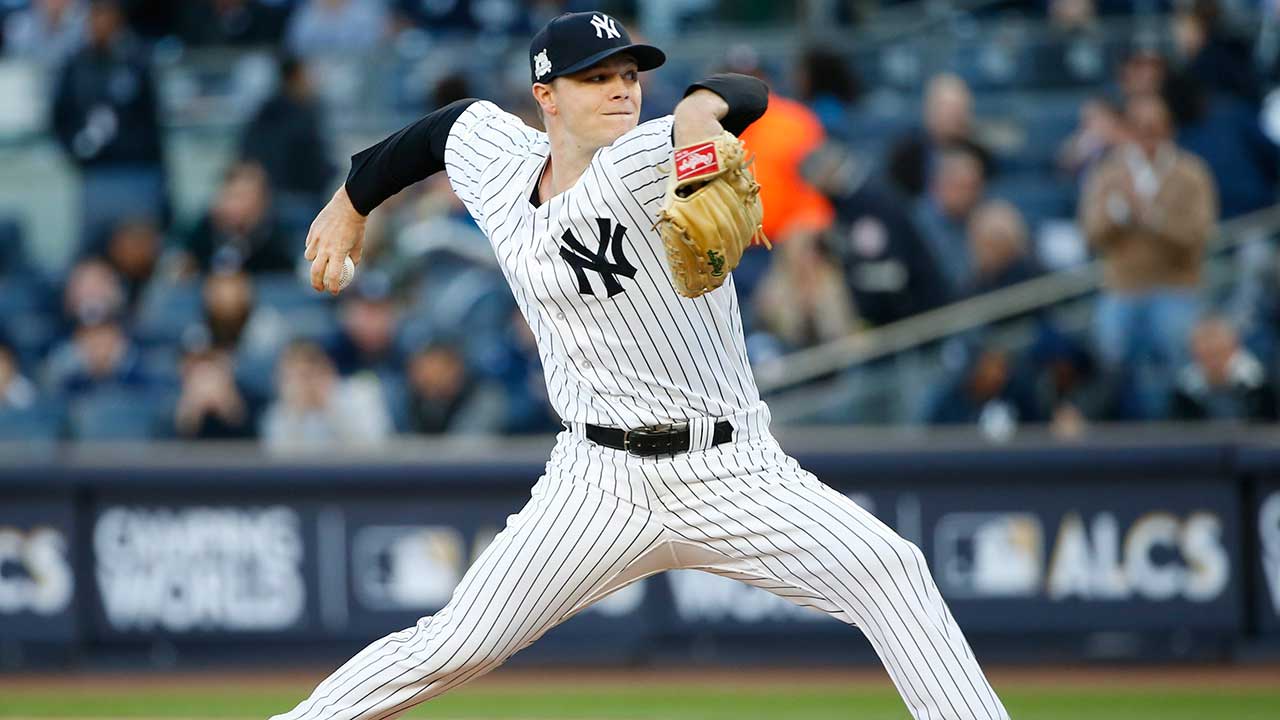The first order of business for the Toronto Blue Jays this off-season might also be the biggest: hire a manager to lead the group of young players now arriving in the major-leagues.
That’s just the beginning, though. As always, the Blue Jays have option decisions and non-tender candidates. There are also trade talks to initiate and free agents to pursue.
One way or another this team needs more pitching, better defence and better baserunning. That will mean adding and, in the case of a couple well-respected veterans, it could also mean subtracting. This early in the winter, just about anything’s on the table.
So what should the Blue Jays do? You could make a case for signing Bryce Harper as the left-handed hitting complement to Vladimir Guerrero Jr., but Mark Shapiro has said that’s not happening. More realistically speaking, here’s what I believe a successful off-season would look like in Toronto…
1.) Decline Yangervis Solarte’s option, exercise Justin Smoak’s option
Even if Solarte projects as a near league-average hitter, his struggles as a defender and baserunner make it hard to justify a $5.5 million salary. There’s likely no trade value here, in which case the Blue Jays should simply decline the option.
The team’s $8 million option for Smoak isn’t a steal by any stretch, but it’s worth exercising on a switch-hitter who has combined quiet clubhouse leadership with power, a .350 OBP and good hands at first base.
2.) DFA Dalton Pompey
Once the Blue Jays need to clear 40-man space for Rule 5-eligible prospects, it makes sense to part with Pompey, who’s clearly no longer part of the team’s plans. Don’t expect much of a return for the switch-hitter, who might benefit from a fresh start.
3.) Trade Russell Martin and $16 of his $20 million to a contender for a C prospect
Martin remains a skilled receiver behind the plate who gets on base and has the versatility to play around the diamond. But the Blue Jays don’t need that skillset in Toronto now that Danny Jansen’s ready for everyday at-bats. But contending teams could definitely use it. Teams such as…
• Houston: Where Martin Maldonado, Brian McCann and Evan Gattis are all hitting free agency.
• Milwaukee: The Erik Kratz story is great, but can they bank on a repeat performance from the 38-year-old? Instead they could call on Martin, who would draw tons of walks batting eighth in the National League.
• Atlanta: Speaking of NL contenders, the Braves have an opening emerging with Kurt Suzuki hitting the open market. They’re believed to have talked to the Blue Jays about Martin in the past year, which should come as no surprise considering that Atlanta GM Alex Anthopoulos was the one who signed him in Toronto.
Regardless of where the Blue Jays trade Martin, they’ll have to absorb most of his contract, potentially $16 of $20 million, without getting a top prospect in return.
[relatedlinks]
4.) Trade Kendrys Morales and $10 of $12 million for a D prospect
The Blue Jays have more young position players than open positions right now. Soon enough Guerrero Jr. and others could crowd the lineup even more. One solution for the logjam? Open up the DH spot.
Nothing against Morales, a particularly well-liked teammate who finished strong, but he’s not going to be on the next contending Blue Jays team. The front office should do everything possible to move him because of the opportunity it would create for others.
Morales’ $12 million salary is a sunk cost, so the Blue Jays should be open to moving most of it. Unfortunately, there just aren’t that many teams that need a full-time DH. What about the Royals, who know and like Morales from his time in Kansas City? They ranked 25th among the 30 teams in runs scored last year, so they could use the offence.
Maybe it’s a reach, but the Blue Jays would benefit from a deal that sends Morales and $10 million to K.C. for a token prospect. If no deal emerges, the Blue Jays will have to hold onto Morales and see if anything changes in spring training.
5.) Listen to trade offers for Kevin Pillar, Randal Grichuk, Marcus Stroman, Aaron Sanchez and Ken Giles
GM Ross Atkins has said that he’ll be willing to listen on players who are nearing free agency. With just two years of control remaining, Pillar, Grichuk, Stroman, Sanchez and Giles all fit that description; it makes sense for the Blue Jays to keep dialogue going in case a truly compelling offer emerges.
Still, if the Blue Jays can find a taker for Morales they’d suddenly have everyday at-bats for Pillar, Grichuk, Billy McKinney and Teoscar Hernandez. And even if there’s no taker for Morales, there’s nothing wrong with rotating four outfielders through three spots until injuries inevitably strike.
As for Stroman, Sanchez and likely Giles, it’d be selling low to move them now. Better to let them rebuild value in Toronto.
6.) Trade Aledmys Diaz to a contender for pitching
With more infielders than spots available, the Blue Jays will be looking to trade from depth this off-season. So who stays and who goes? Troy Tulowitzki’s not movable, and it’d be selling low to shop Devon Travis or Brandon Drury.
Aledmys Diaz, on the other hand, has some trade value given his four years of team control remaining and ability to handle short or third. The 28-year-old posted a 106 OPS+ with 18 homers in 2018, so his value has presumably risen since last winter, when the Blue Jays obtained him for J.B. Woodman, a low-A outfielder who was old for his level.
Still, how much surplus value does Diaz have if you can sign Mike Moustakas for $6.5 million or land Eduardo Nunez for $8 million over two years? We aren’t talking about a franchise-changing return here.
Cleveland looks like a possible suitor given Jason Kipnis’ declining offence and Josh Donaldson’s upcoming free agency. A better fit might exist in New York, though. The Yankees are looking to trade Sonny Gray and need infield help while Didi Gregorius recovers from Tommy John surgery. A Gray-Diaz swap would give them insurance in case they can’t land Manny Machado.
As for the Blue Jays, Gray’s admittedly a counter-intuitive target since he’s a free agent after the year. That gives the Toronto front office just one shot to convert the right-hander into prospects. But Gray has pitched well everywhere except Yankee Stadium, so there’s real bounce-back potential here. Think of it as an upside play: high-risk, high-reward.
In the balance, the Blue Jays could fairly trade Diaz to New York for Gray and a low-level prospect, someone like Trevor Lane, a left-handed reliever who struck out 82 hitters over 68 innings between high-A and double-A this year.
[snippet id=3305549]
7.) Sign a starting pitcher to a short-term deal
Just because the Blue Jays are rebuilding doesn’t mean that they can punt on the starting rotation. There’s something to be said for guarding against Orioles- or Royals-level ineptitude, and a shrewd signing can give the front office a trade chip next summer.
The Cubs were aggressive in the starting pitching market during their rebuild, signing mid-rotation arms Jason Hammel, Scott Feldman and Edwin Jackson. The Astros had a similar approach, signing the likes of Feldman and Erik Bedard.
In hindsight the Cubs were overly aggressive on Jackson, who signed for $52 million, but big-picture these deals paid off. They traded Feldman for Jake Arrieta and Hammel helped them land Addison Russell.
The Blue Jays themselves pulled off one of these deals this summer, when they obtained Drury and McKinney for J.A. Happ (whose strong finish makes a new deal with New York easier to envision than a return to Toronto).
Nathan Eovaldi’s triple-digit velocity sure looks intriguing, but he’s becoming one of the more appealing free agent starters out there. If it takes three years to land Eovaldi, the Blue Jays should instead pursue someone like Trevor Cahill, who had a 3.76 ERA with strong peripherals for the Athletics this year. It’s imaginable that the Blue Jays could land Cahill on a front-loaded Andrew Cashner-type deal: two years and $16 million.
8.) Tender most arbitration-eligible players
There’s a case to be made for tendering every arbitration eligible player except Solarte and reliever Jake Petricka. Credit Petricka for putting together a bounce-back season, but his projected $1.7 million salary looks high.
9.) Add more starting pitching
If the Blue Jays were to add two big-league starters like Gray and Cahill, their triple-A rotation would look something like this:
Sean Reid-Foley
Thomas Pannone
Sam Gaviglio
Jacob Waguespack
Jordan Romano
Eventually Julian Merryweather would join that group, too. Still, injuries strike every season, so the Blue Jays should add layers of starting pitching to ensure that they aren’t scrambling.
On the high end, they should pursue Jon Gray, who was left off of the Rockies’ NLDS roster. Diaz, Travis and Drury could be of some interest to Colorado given that DJ LeMahieu’s on the brink of free agency. If nothing materializes with the Rockies, the Blue Jays should at least add an intriguing minor-league free agent or two.
10.) Slow-play the free agent relief market
The bullpen’s another need for the Blue Jays, who will be losing Tyler Clippard to free agency. There’s no reason not to aim high and see if you can trade for a controllable reliever with a swing and miss offering like Zac Rosscup of the Dodgers (slider), Austen Williams of the Nationals (curve) or Caleb Frare of the White Sox (slider).
In the end, those pitchers will be tough to acquire assuming their current teams value them highly. That leads to Adam Conley of the Marlins, whose fastball and change-up both played up in relief this year. The 28-year-old projects to earn a raise in arbitration, setting up the possibility of trade talks with the perpetually under-funded Marlins. If the Blue Jays could land Conley for, say, Max Pentecost and Justin Shafer that’d be a win–mostly because of Conley’s upside but also because it would clear 40-man space.
Even then, the Blue Jays need multiple relievers. If they were on the brink of contention, I’d suggest pushing for a higher-tier arm, even if it meant spending at the top of the market. In this case there’s no need to rush, though.
In fact, the Blue Jays will be better positioned at the trade deadline if the free agents they sign are both effective and affordable. With that in mind, they should slow-play the market for a class of relievers including Joakim Soria, Adam Warren, Kelvin Herrera, Daniel Hudson, Jesse Chavez, Brad Brach and Sergio Romo.
Once spring training approaches and unsigned veterans are looking for leverage innings, the Blue Jays can sign two of them to affordable one-year deals.
Results
Additions: Sonny Gray, Trevor Cahill, Adam Conley, two veteran relievers, one starting pitcher on a minor-league deal, three low-level prospects
Subtractions: Yangervis Solarte, Dalton Pompey, Russell Martin, Kendrys Morales, Aledmys Diaz, Jake Petricka, Max Pentecost, Justin Shafer
That’s a lot of departures, but the Blue Jays keep all their top prospects and controllable players in this scenario. The resulting team would have more playing time for young players looking to establish themselves at the MLB level, and from Giles on down, there would also be lots of interesting pitching to trade next summer. All told, this version of the Blue Jays would likely cost $125-130 million.
To be clear, these moves would probably not amount to a good team. The pitching depth drops off quickly and the defence would still project as a weakness. The lineup, while younger, would still skew right-handed, making life easy on opposing managers.
That said, this isn’t the time to for finishing touches. It’s time to see what young players can do and convert veterans into impact young talent for future editions of the Blue Jays.








